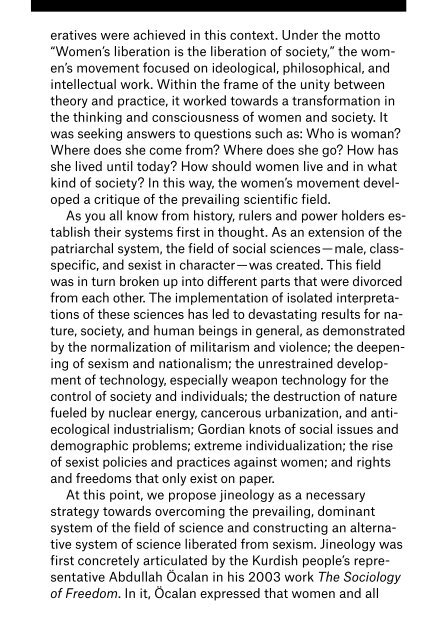Stateless Democracy
NWA5-Stateless-Democracy1.pdf?utm_content=buffer7beda&utm_medium=social&utm_source=twitter
NWA5-Stateless-Democracy1.pdf?utm_content=buffer7beda&utm_medium=social&utm_source=twitter
You also want an ePaper? Increase the reach of your titles
YUMPU automatically turns print PDFs into web optimized ePapers that Google loves.
eratives were achieved in this context. Under the motto<br />
“Women’s liberation is the liberation of society,” the women’s<br />
movement focused on ideological, philosophical, and<br />
intellectual work. Within the frame of the unity between<br />
theory and practice, it worked towards a transformation in<br />
the thinking and consciousness of women and society. It<br />
was seeking answers to questions such as: Who is woman?<br />
Where does she come from? Where does she go? How has<br />
she lived until today? How should women live and in what<br />
kind of society? In this way, the women’s movement developed<br />
a critique of the prevailing scientific field.<br />
As you all know from history, rulers and power holders establish<br />
their systems first in thought. As an extension of the<br />
patriarchal system, the field of social sciences — male, classspecific,<br />
and sexist in character — was created. This field<br />
was in turn broken up into different parts that were divorced<br />
from each other. The implementation of isolated interpretations<br />
of these sciences has led to devastating results for nature,<br />
society, and human beings in general, as demonstrated<br />
by the normalization of militarism and violence; the deepening<br />
of sexism and nationalism; the unrestrained development<br />
of technology, especially weapon technology for the<br />
control of society and individuals; the destruction of nature<br />
fueled by nuclear energy, cancerous urbanization, and antiecological<br />
industrialism; Gordian knots of social issues and<br />
demographic problems; extreme individualization; the rise<br />
of sexist policies and practices against women; and rights<br />
and freedoms that only exist on paper.<br />
At this point, we propose jineology as a necessary<br />
strategy towards overcoming the prevailing, dominant<br />
system of the field of science and constructing an alternative<br />
system of science liberated from sexism. Jineology was<br />
first concretely articulated by the Kurdish people’s representative<br />
Abdullah Öcalan in his 2003 work The Sociology<br />
of Freedom. In it, Öcalan expressed that women and all<br />
individuals, societies, and peoples that are not carriers of<br />
power or heirs to the state need to develop their own and<br />
free social sciences — that these sciences could be called<br />
“the sociology of freedom.” He proposed that this sociology<br />
of freedom could in turn be based on jineology, because<br />
movements that aim at a free, equal, and democratic communal<br />
society have a strong need for jineology.<br />
The term jineology means “women’s science.” Jin is the<br />
Kurdish word for “woman” and logy is derived from the<br />
Greek term logos [knowledge]. Moreover, jin comes from<br />
the Kurdish term jiyan, which means “life.” In the Indo-European<br />
language group and in the Middle East, the words<br />
jin, zin, or zen — all of which mean “woman” — are often<br />
synonymous with life and vitality.<br />
In the history of humanity, woman is evaluated as the<br />
first organism that attained knowledge about her own self.<br />
Life and sociality coalesced on the basis of moral and political<br />
principles, with woman at its center. Natural society,<br />
with its moral and political values, was built by women.<br />
There is an unbreakable bond between women and life.<br />
The woman represents an important part of social nature<br />
with her body and meaning. This is why woman is often<br />
associated with life: woman represents life, life symbolizes<br />
woman. For this reason, jineology as a women’s science is<br />
also referred to as the science of life.<br />
Upon closer examination of the stages of the patriarchal<br />
system, beginning with Sumerian civilization, it is clear<br />
that rulers have established their power positions initially<br />
in thought. The distinction between subject and object in<br />
social structures, for example, was first established by the<br />
modern sciences. This fiction imposed on society the notion<br />
that man is subject and woman is object — Mr. Subject<br />
vs. Mrs. Object, master subject vs. slave object, state subject<br />
vs. society object. This logic of power has made both<br />
women and society believe in this distinction of oppres-<br />
86–87


